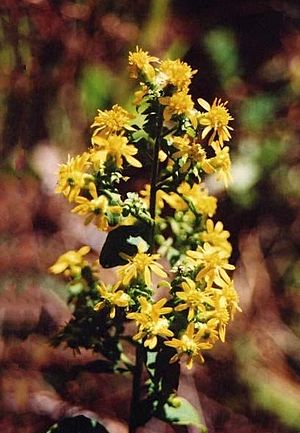Hairy-seed goldenrod facts for kids
Quick facts for kids Hairy-seed goldenrod |
|
|---|---|
 |
|
| Conservation status | |
| Scientific classification | |
| Genus: |
Solidago
|
| Species: |
villosicarpa
|
Solidago villosicarpa is a special kind of flowering plant. It belongs to the aster family, which includes many well-known flowers like daisies. People call it by several names, such as hairy-seed goldenrod or coastal goldenrod. This plant is only found in North Carolina, United States. It's quite rare, with only four groups of them known to exist.
This goldenrod is part of a larger group called Solidago Squarrosae. These plants grow in eastern Canada and the United States, usually east of the Rocky Mountains.
Contents
Discovering the Hairy-Seed Goldenrod
Scientists first collected Solidago villosicarpa in 1949. For many years, they thought it was a different plant. But in the year 2000, experts finally realized it was a brand new species. They then gave it its own scientific name.
What Does It Look Like?
This plant is a perennial herb, meaning it lives for more than two years. It can grow quite tall, up to 1.5 meters (about 5 feet). Usually, it has one straight stem. This stem can be brownish or bluish and feels rough because of tiny hairs.
At the bottom of the plant, there's a group of leaves called a basal rosette. These leaves can be as wide as 30 centimeters (about 1 foot). They often stay on the plant even when it starts to flower. The leaves have jagged edges and are also covered with small hairs.
Flowers of the Goldenrod
The plant produces many flowers in a cluster called an inflorescence. Sometimes, there can be as many as 100 flower heads on one plant. Each flower head is small and yellow.
Inside each head, there are two types of tiny flowers. There are 4 to 8 yellow ray florets, which look like petals. These surround 10 to 18 disc florets in the center. After the flowers bloom, the plant produces fruits. These fruits are covered in long, soft hairs, which is why it's called "hairy-seed goldenrod."
Where the Goldenrod Lives
This special plant is native to the coastal plain of North Carolina. This means it naturally grows in the flat, low-lying areas near the coast. It can be found in different types of places. However, it always grows close to an estuary. An estuary is where a river meets the sea, mixing fresh and saltwater.
Preferred Habitats
The hairy-seed goldenrod grows in several kinds of forests. It also lives in maritime scrub, which is a type of bushy area near the sea. You can find it right on the coast or a bit further inland next to waters affected by tides.
How It Handles Change
This plant seems to do well with changes in its environment. For example, it responds positively when trees around it are cut down, like during logging. It also thrives after hurricanes blow down surrounding trees. This suggests the plant doesn't like a lot of shade. It grows better when the tree canopy above it is open or removed, allowing more sunlight to reach it.
Protecting a Rare Plant
The hairy-seed goldenrod is considered "critically imperiled." This means it is in great danger of disappearing. There are only four known groups of these plants left in the world. Each group has between 100 and 1400 individual plants. Protecting their habitats is very important to help this unique species survive.


